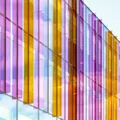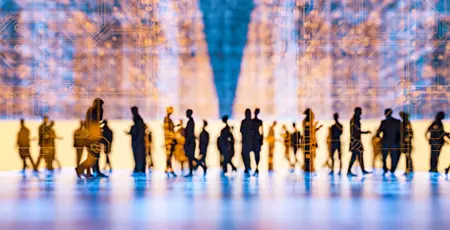Digital age for the NHS
NHS staff have begun using the Data Visualisation Observatory at AMBS.
In a groundbreaking partnership, NHS staff have begun using the Data Visualisation Observatory (DVO) at AMBS as part of a blended learning course at The University of Manchester.
Aimed at upskilling the healthcare workforce to prepare for digital transformation, Data Visualisation and Communication is a core unit on the PGCert in the Clinical Data Science programme funded by NHS England.
The course aims to provide students with a bridge between what they are doing clinically and the world of data science. Attendees all work in health and social care and range from doctors and nurses through to physiotherapists, pharmacists and lab technicians to name a few.
Exploring data sets
Alan Davies, Senior Lecturer in Health Data Sciences and Programme Director for Clinical Data Science, said the DVO was being used to show students how such a facility can be used to explore data sets, as well as providing a gallery for them to critique selected visualisations as well as their own group-based paper prototypes.
During their sessions they also get formative feedback on their designs from members of the public who are lay reps on the course.
As he explained: "Given the name of the course unit it made perfect sense for us to start using the DVO and we began using it last year with our first cohort of 30 students from across the country. This academic year we have 50 people on the course and in future we are hoping to have as many as 100.
"One of the great benefits of this course is that attendees can bring their own clinical challenges into the classroom and start thinking about how datasets can help them in their day-to-day work. One of the key aims here is building long term impact and communities of practice.
"We have already had people who have completed the course contacting us and saying they are putting into practice what they have learnt, helping them to solve specific problems."
Dr Davies added that another benefit was getting in front of senior people in the NHS. "Right now, a lot of senior managers are working on real world digital projects and the DVO is a great way to make these projects come alive.
"A virtual gallery like the DVO gets people walking around, gets them off their feet, and provides a novel way of facilitating group working. I am also really open to novel ways of how we might use the DVO more in the future."
Virtual Reality (VR) in healthcare
Meanwhile the DVO is also helping promote the use of Virtual Reality (VR) headsets in the healthcare industry through a unique collaboration with academics at the University of Manchester.
The partnership is being driven by Dr Gareth Kitchen, a consultant anaesthetist by training who is also a Clinical Senior Lecturer at the University. Dr Kitchen originally completed a PhD at the university and then went on to take a Development and Skills Enhancement Award focusing on industry and entrepreneurship.
Through this study he became interested in the potential of wearable technology to track patient information and observations in hospitals, and specifically how data sets could be superimposed into VR headsets to help clinicians.
As Dr Kitchen explains: "I started working with the DVO on developing specific visualisation tools which could be used in VR headsets to aid handover between doctors changing shifts who work in critical care. In particular, we looked at developing programmes which could help prioritise patient information.
"Using headsets the idea is that doctors can see everything they need to know about a specific patient and understand what may or may not have changed since they were last on shift.
Dr Qudamah Quboa from the DVO said all initial prototypes for the project were built by the DVO. "This is potentially a really big opportunity for the DVO. The medical sector has been one of the first to really explore the full potential of using VR headsets in the workplace and we can really help research this groundbreaking area.
"With a VR headset the user just sees exactly what is in the headset like with a computer game for instance.
"But this work also links with the growing use of augmented reality (AR) headsets where the user can see what is in front of them while information and data is then overlaid into your field of vision. Users can also flick between VR and Augmented Reality (AR) as need be."
"One of the big challenges with this idea is how to feed real-time data into the system and hence our exciting collaboration with the DVO to explore what was possible."
Tags:






